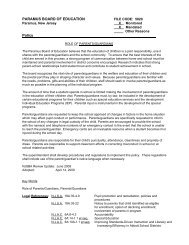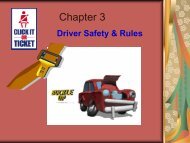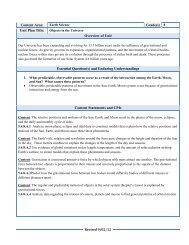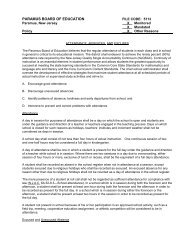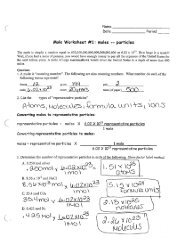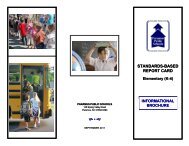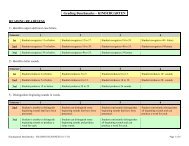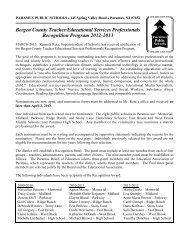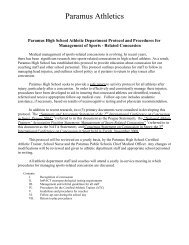Portfolio Assessment - Teacher Notes
Portfolio Assessment - Teacher Notes
Portfolio Assessment - Teacher Notes
You also want an ePaper? Increase the reach of your titles
YUMPU automatically turns print PDFs into web optimized ePapers that Google loves.
GRADE THREE<br />
READING AND LANGUAGE ARTS LITERACY<br />
TABLE OF CONTENTS<br />
Grade Three Introduction<br />
NJ Core Content Curriculum Standards for Grade Three<br />
Reading<br />
Read Aloud<br />
Shared Reading<br />
Guided Reading<br />
Independent Reading<br />
Writing<br />
Shared Writing<br />
Independent Writing<br />
Word Study/Vocabulary<br />
Viewing<br />
Grade Three Reading and Writing <strong>Assessment</strong>s
GRADE THREE<br />
READING AND LANGUAGE ARTS LITERACY<br />
Language is a social contract that allows people to communicate with one another. Our<br />
primary goal, then, is to ensure that every child is given the opportunity to discover him or herself<br />
in relation to others and the world we live in through language. Thus, we have chosen to break<br />
the intermediate literacy curriculum into the following areas:<br />
• Reading<br />
• Writing<br />
• Speaking<br />
• Viewing<br />
This mirrors the NJ Core Content Curriculum Standards, which are part of the Table of<br />
Contents, with one exception. Listening, for purposes of this curriculum, is integrated into the<br />
other areas.<br />
Keeping the curriculum manageable while including the components of a balanced<br />
literacy program is no easy feat. Clearly, hundreds of solid activities are possible. With that in<br />
mind, notice the link to the NCTE website www.read/write/think.org.<br />
What is essential, however, is that the component parts of a balanced literacy program all<br />
play a role in the Grade Three classroom. Indeed, our primary goal of meeting each child at the<br />
place of his or her needs cannot be accomplished without such a balance.<br />
A Table of Contents containing these component parts is book marked to the left of this<br />
page. Each will lead to a single page on which the student outcome is delineated; the desired<br />
activity is described—both in general and for grade level—and the materials needed to<br />
accomplish that goal and the expected assessment/evaluation are noted. Included as well in the<br />
Contents are a Reading List for Grade Three, with Required and Suggested titles noted as such,<br />
all of the assessments in the Grade Three <strong>Portfolio</strong>, and a Glossary of terms that have been<br />
italicized throughout the curriculum.<br />
Finally, readers will notice a lot of white space on each of the pages. The space is there<br />
because we are approaching this document as a draft that will be in constant revision. We would<br />
love, therefore, for you to occasionally print out a page. If you are new to the profession, we<br />
would love for you to jot notes regarding clarity and completeness in those open spaces. If you<br />
are one of our seasoned veterans, we would love for you to make more substantive suggestions.<br />
These may be turned in to the Reading Specialist at your school for annual consideration during<br />
our review of these materials.
NJ Core Curriculum Content Standards<br />
for<br />
Language Arts Literacy<br />
Grade Three<br />
3.1 READING<br />
A. CONCEPTS ABOUT PRINT<br />
1. Recognize that printed materials provide specific information.<br />
2. Recognize purposes for print conventions such as end-sentence punctuation, paragraphing, and<br />
bold print.<br />
3. Use a glossary or index to locate information in a text.<br />
B. PHONOLOGICAL AWARENESS (Includes Phonemic Awareness)<br />
1. Demonstrate a sophisticated sense of sound-symbol relationships, including all phonemes (eg.,<br />
blends, digraphs, diphthongs)<br />
C. DECODING AND WORD RECOGNITION<br />
1. Know sounds for a range of prefixes and suffixes (e.g., re-, ex-, -ment, -tion).<br />
2. Use letter-sound knowledge and structural analysis to decode words.<br />
3. Use context to accurately read words with more than one pronunciation.<br />
D. FLUENCY<br />
1. Recognize grade-level words accurately and with ease so that a text sounds like spoken<br />
language when read aloud.<br />
2. Read longer text and chapter books independently and silently.<br />
3. Read aloud with proper phrasing, inflection, and intonation.<br />
E. READING STRATEGIES (Before, During, and After Reading)<br />
1. Set purpose for reading and check to verify or change predictions during/after reading.<br />
2. Monitor comprehension and accuracy while reading in context and self-correct errors.<br />
3. Use pictures and context clues to assist with decoding of new words.<br />
4. Develop and use graphic organizers to build on experiences and extend learning.<br />
F. VOCABULARY AND CONCEPT DEVELOPMENT<br />
1. Spell previously studied words and spelling patterns accurately.<br />
2. Point to or clearly identify specific words or wording that are causing comprehension difficulties.<br />
3. Infer word meanings from taught roots, prefixes, and suffixes.<br />
4. Use a grade-appropriate dictionary with assistance from teacher.<br />
5. Use pictures and context clues to assist with meaning of new words.<br />
G. COMPREHENSION SKILLS AND RESPONSE TO TEXT<br />
1. Recognize purpose of the text.<br />
2. Distinguish cause/effect, fact/opinion, main idea/supporting details in interpreting texts.<br />
3. Interpret information in graphs, charts, and diagrams.<br />
4. Ask how, why, and what-if questions in interpreting nonfiction texts.<br />
5. Recognize how authors use humor, sarcasm, and imagery to extend meaning.<br />
6. Discuss underlying theme or message in interpreting fiction.<br />
7. Summarize major points from fiction and nonfiction texts.<br />
8. Draw conclusions and inferences from texts.<br />
9. Recognize first-person “I” point of view.<br />
10. Compare and contrast story plots, characters, settings, and themes.<br />
11. Participate in creative responses to texts (e.g., dramatizations, oral presentations).
3.2 WRITING<br />
12. Read regularly in materials appropriate for their independent reading level.<br />
13. Read and comprehend both fiction and nonfiction that is appropriately designed for grade level.<br />
14. Use information and reasoning to examine bases of hypotheses and opinions.<br />
H. INQUIRY AND RESEARCH<br />
1. Use library classification systems, print or electronic, to locate information.<br />
2. Draw conclusions from information and data gathered.<br />
3. Read a variety of nonfiction and fiction books and produce evidence of understanding.<br />
A. WRITING AS PROCESS (Prewriting, Drafting, Revising, Editing, Postwriting)<br />
1. Generate possible ideas for writing through recalling experiences, listening to stories, reading,<br />
brainstorming, and discussion.<br />
2. Examine real-world examples of writing in various genres to gain understanding of how authors<br />
communicate ideas through form, structure, and author’s voice.<br />
3. Use graphic organizers to assist with planning writing.<br />
4. Compose first drafts from prewriting work.<br />
5. Revise a draft by rereading with meaning, narrowing the focus, sequencing, elaborating with<br />
detail, improving openings, closings, and word choice to show voice.<br />
6. Participate with peers to comment on and react to each other’s writing.<br />
7. Build awareness of ways authors use paragraphs to support meaning.<br />
8. Begin to develop author’s voice in own writing.<br />
9. Use reference materials to revise work, such as a dictionary or internet/software resource.<br />
10. Edit work for basic spelling and mechanics.<br />
11. Use computer word-processing applications during parts of the writing process.<br />
12. Understand and use a checklist and/or rubric to improve writing.<br />
13. Reflect on own writing, noting strengths and areas needing improvement.<br />
B. WRITING AS A PRODUCT (Resulting in a formal product or publication)<br />
1. Write a descriptive piece, such as a description of a person, place, or object.<br />
2. Write a narrative piece based on personal experience.<br />
3. Write a nonfiction piece and/or simple informational report across the curriculum.<br />
4. Present and discuss writing with other students.<br />
5. Apply elements of grade-appropriate rubrics to improve writing.<br />
6. Develop a collection of writings (e.g., a literacy folder or portfolio).<br />
C. MECHANICS, SPELLING, AND HANDWRITING<br />
1. Use Standard English conventions that are developmentally appropriate to the grade level:<br />
sentences, punctuation, capitalization, and spelling.<br />
2. Use grade-appropriate knowledge of English grammar and usage to craft writing: singular and<br />
plural nouns, subject/verb agreement, appropriate parts of speech.<br />
3. Study examples of narrative and expository writing to develop understanding of paragraphs and<br />
indentation.<br />
4. Develop knowledge of English spelling through the use of patterns, structural analysis, and high<br />
frequency words.<br />
5. Write legibly in manuscript or cursive to meet district standards.<br />
D. WRITING FORMS, AUDIENCES, AND PURPOSES (Exploring a variety of forms)<br />
1. Write for a variety of purposes (e.g., to inform, entertain, persuade) and audiences (e.g., self,<br />
peers, community).<br />
2. Develop fluency by writing daily and for sustained amounts of time.<br />
3. Generate ideas for writing in a variety of situations and across the curriculum.<br />
4. Write to express thoughts and ideas, to share experiences, and to communicate socially.<br />
5. Write the events of a story sequentially.<br />
6. Produce writing that demonstrates the use of a variety of sentence types, such as declarative,<br />
interrogative, exclamatory, and imperative.<br />
7. Respond to literature through writing to demonstrate an understanding of the text.<br />
8. Write narrative text (e.g., realistic, humorous, etc.)<br />
9. Write non-fiction text (e.g., reports, procedures, and letters).
3.3. SPEAKING<br />
A. DISCUSSION<br />
1. Listen and follow a discussion in order to contribute appropriately.<br />
2. Stay focused on topic.<br />
3. Take turns.<br />
4. Support an opinion with details.<br />
B. QUESTIONING (Inquiry) AND CONTRIBUTING<br />
1. Develop appropriate questions to explore a topic.<br />
2. Contribute information, ideas, and experiences to classroom inquiry.<br />
C. WORD CHOICE<br />
1. Use vocabulary related to a particular topic.<br />
2. Adapt language to persuade, explain, or seek information.<br />
3. Use new vocabulary and figurative language learned from literature and classroom experiences.<br />
D. ORAL PRESENTATION<br />
3.4 LISTENING<br />
1. Use pictures to support an oral presentation.<br />
2. Attempt to revise future presentations based on feedback from peers and teacher.<br />
3. Use appropriate strategies to prepare, rehearse and deliver an oral presentation: word choice,<br />
expression, eye contact and volume.<br />
A. ACTIVE LISTENING<br />
1. Connect messages heard to prior knowledge and experiences.<br />
2. Exchange information through verbal and nonverbal messages.<br />
B. LISTENING COMPREHENSION<br />
1. Follow two- and three-step directions. ∗<br />
2. Listen to a story read aloud and/or information from television or film, and summarize main<br />
ideas.<br />
3. Paraphrase information shared by others.<br />
3.5 VIEWING AND MEDIA LITERACY<br />
A. CONSTRUCTING MEANING<br />
1. Begin to demonstrate an awareness of different media forms and how they contribute to<br />
communication.<br />
2. Identify the central theme and main ideas in different media.<br />
B. VISUAL AND VERBAL MESSAGES<br />
1. Recognize the effects of visual arts on one’s mood and emotions.<br />
2. Begin to explore and interpret messages found in advertisements and other texts.<br />
∗ Standard 3.4.B1 applies to all discipline areas and classroom practices. As such, it is not keyed into the curriculum<br />
proper; rather, it is an overarching expectation.
GRADE THREE<br />
READING<br />
Outcome: Students will develop awareness of concepts of print, fluency, and new vocabulary, as well as<br />
improved listening skills.<br />
Read Aloud<br />
ACTIVITIES<br />
NJ CCCS Addressed: 3.1.A1-2, E1-4, G1-11, G14; 3.3.A1-2, B1-2, C1-3; 3.4.A1-2, B2<br />
Reading aloud is first and foremost a modeling strategy. It is teacher-centered, in that the teacher reads and the students<br />
listen. The teacher also pauses at significant points and asks the students to interact with the reading by inviting students<br />
to comment, ask/answer questions, and by generally eliciting discussion of the text. The teacher also models his/her own<br />
thinking, especially as that thinking relates to comprehension, in order to demonstrate how experienced readers interact<br />
with text as they read.<br />
Reading should not be interrupted too frequently or for too long a period of time or fluency will be lost.<br />
At this level, Read Aloud should be planned carefully as an introduction to new material or as a scaffold for difficult<br />
material.<br />
MATERIALS<br />
See Grade Three Reading List, especially Quality Literature titles for this grade level.<br />
Observation (including written notes):<br />
• Responses to Question/Answer<br />
• Willingness to contribute<br />
Tiered Assignments<br />
ASSESSMENT/EVALUATION
GRADE THREE<br />
READING<br />
Outcome: Students will develop awareness of concepts of print, fluency, retelling and other<br />
comprehension strategies, as well as improved listening skills.<br />
Shared Reading<br />
ACTIVITIES<br />
NJ CCCS Addressed: 3.1.A3, E1-4, G1-11, G13-14; 3.3.A1-4, B1-2, C1-3; 3.4.A1-2, B3<br />
Shared Reading attempts to build a level playing field through whole-class instruction. The teacher reads the text aloud,<br />
while students are expected to follow along in the text as it is read.<br />
This is the place where Think Aloud becomes most effective and the teacher can demonstrate—and then invite students<br />
to reveal—those strategies they use to make meaning of text.<br />
At this level, Shared Reading addresses:<br />
• awareness of text conventions<br />
• similarities and differences between fiction and nonfiction<br />
• developing a sense of story or content<br />
• fluency and phrasing<br />
• comprehension through retelling<br />
• comprehension through reading strategies<br />
At this level, Shared Reading should occur only between the teacher and students who are known to be good oral<br />
readers. Struggling readers’ mispronunciations and miscues can have a deleterious effect on the entire group.<br />
MATERIALS<br />
See Grade Three Reading List, especially Quality Literature titles<br />
Easel<br />
Chart Paper<br />
Other paper—including drawing and writing<br />
Markers<br />
ASSESSMENT/EVALUATION (See <strong>Portfolio</strong>)<br />
Observation (including written notes):<br />
• Evidence that individual students are using particular reading strategies<br />
• Willingness to contribute<br />
Tiered Assignments
GRADE THREE<br />
READING<br />
Outcome: Students will demonstrate understanding of genre, more sophisticated concepts of print, and<br />
appropriate use of reading strategies.<br />
ACTIVITIES<br />
Guided Reading<br />
NJ CCCS Addressed: 3.1.A3, D1-3, E1-4, F2, F5, G1-11, G13-14; 3.3.A1-4, B1-2, C1-3; 3.4.A1-2, B3<br />
Pulls together students with similar reading behaviors so that the instruction they receive is tailored to needs.<br />
Before reading: The teacher introduces the book or passage for guided reading and provides a scaffold for reading by<br />
connecting students’ prior knowledge and experiences to the text. Next, the teacher states clearly the skill or strategy the<br />
lesson will focus on (the goal of the lesson).<br />
While reading: Students read independently in small voice, attempting to meet the goals as stated. As students read, the<br />
teacher responds individually to each of the students, taking a running record not only on the stated goal but on all<br />
aspects of the reading that deal with basic concepts of print, decoding, and comprehension. The correspondence of<br />
running records should be one student for each lesson.<br />
After reading: Students discuss and reflect on the reading process and problem-solving strategies. The teacher then<br />
provides small group instruction through a mini-language lesson and/or interactive word work. Finally, students practice<br />
the concept, skill, or strategy using paired reading, independent reading, sequencing activities, cloze with the same story,<br />
written responses to the ending, written reflection on the reading process/goals, or comprehension reinforcement through<br />
interpretation—art, music, or drama.<br />
At this level, Guided Reading should be used only with students who come to class able to read.<br />
Leveled books<br />
Easel<br />
Chart Paper<br />
Clipboard<br />
Other paper—both for drawing and writing<br />
Markers<br />
MATERIALS<br />
ASSESSMENT/EVALUATION<br />
QRI<br />
Observation and conferencing based on independent reading<br />
Practice exercises<br />
Formal tests from basal program—Scholastic Unit Tests<br />
Story maps
GRADE THREE<br />
READING<br />
Outcome: Students will practice reading strategies, expand reading experience based on interest, develop<br />
fluency, and become self-confident readers by reading and rereading texts.<br />
ACTIVITIES<br />
Independent Reading<br />
NJ CCCS Addressed: 3.1.E1-4, G12<br />
Independent Reading is time set aside to reinforce all those skills and strategies students have practiced.<br />
Independent Reading may be addressed through D.E.A.R. time, Buddy Reading, and Poetry Books.<br />
It is essential that students be discouraged from reading above grade level during Independent Reading.<br />
MATERIALS<br />
Individual book baskets, boxes, or bags containing leveled books in all genres<br />
Classroom library with a choice of books categorized by author, theme, and/or genre/Accelerated readers<br />
ASSESSMENT/EVALUATION<br />
Note: Although D.E.A.R. and Sustained Silent Reading were once viewed as times when the teacher should<br />
not interact with students, current pedagogy suggests that teachers should interact with individual<br />
students during Independent Reading time.<br />
QRI<br />
Observation and conferencing based on independent reading<br />
Reading journal
GRADE THREE<br />
WRITING<br />
Outcome: Students will develop awareness of how text is produced, revised, and edited.<br />
Modeled/Shared Writing<br />
ACTIVITIES<br />
NJ CCCS Addressed: 3.2.A1-3, A7, B1-6, C3; 3.3.A1-4, B1-2, C1-3; 3.4.A1-2, B3<br />
<strong>Teacher</strong> and students collaborate to write text.<br />
At this level, Modeled/Shared Writing addresses:<br />
• understanding of concepts of print<br />
• writing strategies<br />
• understanding of writing styles<br />
• improvement of sentence structure<br />
• the effect of word choice on writing<br />
Modeled/Shared Writing also supports reading development because it produces text that students can read<br />
independently.<br />
MATERIALS<br />
Easel<br />
Chart Paper<br />
Markers<br />
Books—both classroom and library—and computer for researching topics of interest<br />
ASSESSMENT/EVALUATION<br />
Observation (including written notes) regarding how individual students are responding during Modeled/Shared Writing.<br />
(For example, when students contribute, is it clear that the contribution follows from what has gone before or that some<br />
other strategy—like revision—is at the heart of the contribution?)
GRADE THREE<br />
WRITING<br />
Outcome: Students will begin writing with an eye toward producing text in their personal voices.<br />
Independent Writing<br />
ACTIVITIES<br />
NJ CCCS Addressed: 3.1.H1-3; 3.2.A1, A3-6, A8-13, B1-6, C1-2, C5, D1-9<br />
Students compose their own text.<br />
Like Independent Reading, Independent Writing fosters the understanding that learning is a personal commitment.<br />
Independent Writing gives students practice in generating ideas and organizing these into an outline or other graphic<br />
organizer before writing.<br />
Practice on own or peer writing follows minilessons on sentence structure, usage, and mechanics.<br />
Workshop format allows for independent, peer, and conferencing work to go on simultaneously.<br />
MATERIALS<br />
Various kinds of paper, lined and unlined<br />
Pencils<br />
Pens, markers<br />
Crayons for illustrations<br />
Story starters<br />
Student writing folders<br />
Graphic organizers, semantic maps, or structured overview to help organize and clarify relationships before writing<br />
Picture books to teach particular elements of writing<br />
Conferencing<br />
<strong>Portfolio</strong><br />
Author’s Chair<br />
ASSESSMENT/EVALUATION
GRADE THREE<br />
WORD STUDY/VOCABULARY<br />
Outcome: Students will continue to develop both common and lesson-based vocabulary.<br />
ACTIVITIES<br />
NJCCCS Addressed: 3.1.B1, C1-3, F1, F3-4; 3.2.C4; 3.3.C1-3<br />
Word Meaning: At this level, students will<br />
• infer relationships between object pairs (analogies)<br />
• recognize and use word opposites (antonyms)<br />
• decode new words phonetically<br />
• use context clues to determine definitions of new words<br />
• use and spell common homophones/homographs correctly<br />
• demonstrate understanding of multiple meanings of words<br />
• use prior knowledge to build vocabulary by learning and using words with similar meanings (synonyms)<br />
• use syntactic structures (e.g., appositives, adjective phrases) to determine definitions of new words<br />
• learn to use a thesaurus to locate more precise vocabulary for papers/themes<br />
Word Structure: At this level, students will<br />
• identify root words<br />
• manipulate word meaning using prefixes and suffixes<br />
Dictionaries, thesauruses, and other reference works<br />
Wall charts and lists<br />
Graphic organizers to represent vocabulary words<br />
MATERIALS<br />
Samples of student writing<br />
Standardized test results<br />
ASSESSMENT/EVALUATION
GRADE THREE<br />
VIEWING<br />
Outcome: Students will develop awareness of how illustrations and charts/graphs affect text, and will begin<br />
to retell and interpret messages encountered in electronic media.<br />
MEDIA<br />
NJ CCCS Addressed: 3.5.A1-2, B1-2<br />
ACTIVITIES<br />
Statistics vary on the amount of mass media with which the average American citizen—and more specifically, American<br />
children—are bombarded.<br />
Recognition of the role that print media (including illustrations and charts/graphs) and electronic media play on the<br />
development of a student’s linguistic ability shifts from being the domain of the teacher to the responsibility of the<br />
student who needs to develop awareness of how subtle messages influence his or her thinking and response to the world<br />
at large.<br />
MATERIALS<br />
Media samples from newspapers, magazines, and Internet appropriate to age/reading level<br />
ASSESSMENT/EVALUATION<br />
Observation (including written notes):<br />
• Responses to Question/Answer<br />
• Willingness to contribute




